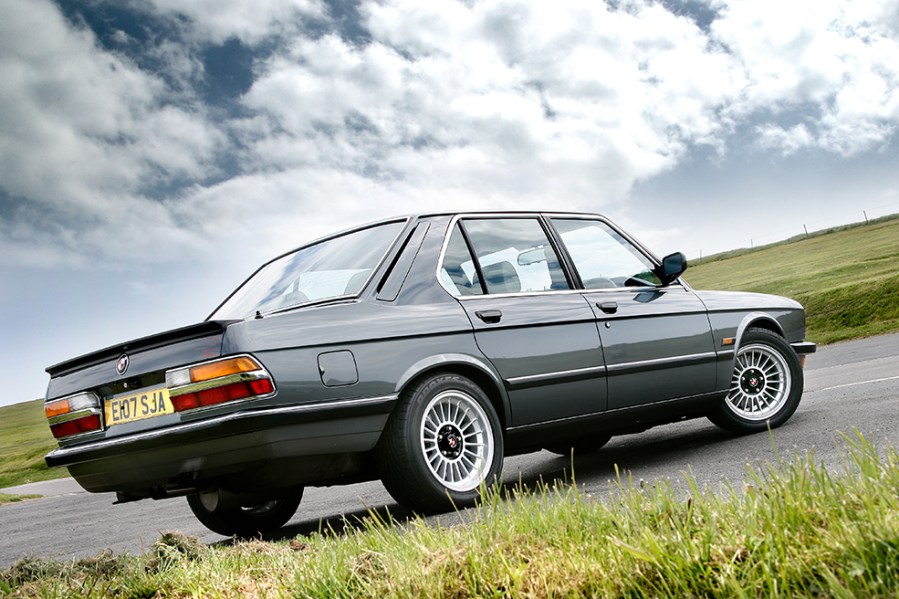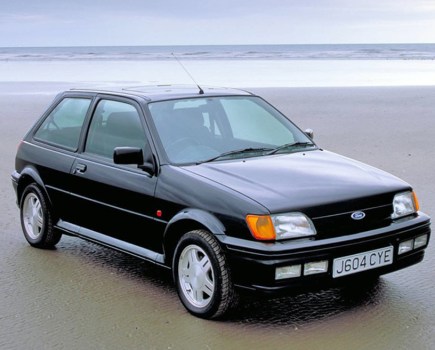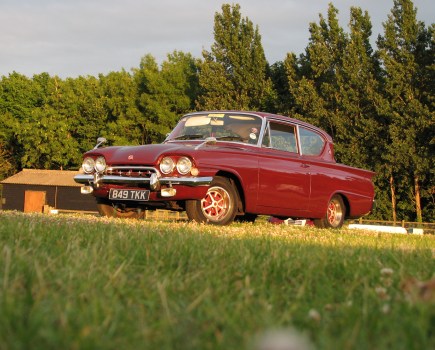The BMW E28 5 Series was one of the most handsome cars of the 1980s and remains a fantastic driver-focused sports saloon today
Words: Andrew Everett Images: Jackie Skelton
When it was launched 35 years ago, the new BMW E28 5 Series looked like little more than a facelifted BMW E12 5 Series, a car that had been around since 1972. The E12 had earned itself a fine reputation as a well-made, mid-range saloon that ranged from the 518 to the hot-rodded 528i and M535i.
Launched in September 1981, the E28 5 series range started with the 518, powered by a 90bhp four-cylinder known by its M10 engine code. A 518 with optional five-speed gearbox and power steering was next up the chain, followed by six-cylinder cars, all with five speeds and PAS, with the 125bhp M20 520i and 150bhp M30 525i, plus the 184bhp M30 528i with standard alloy wheels and electric front windows. A three-speed ZF automatic box was optional on all six-cylinder cars as well.
The year 1981 was only one year before progressively designed cars like the Ford Sierra started to appear, so the E28 already looked slightly old-fashioned when it was launched. The BMW’s contemporary Mercedes W123 rival was similarly traditional, however.
The E28 had a distinct BMW identity and was nicely proportioned and detailed inside and out. While it looked like the E12, very little of the body was carried over – just the roof skin, doors (with modifications), plus front and rear screens.
Suspension and brakes were all completely revised with no carryover parts whilst the chassis and inner wings were all revised with different pick up points. The interior was also all-new, with a new ‘Service Indicator’ system that made its way onto other BMWs thereafter.
In late 1982 the 520i gained the new M20 engine from the E30 3 Series, with a revised cylinder-head and LE Jetronic; all M30 six-cylinders had a new Getrag 260 gearbox gradually phased in, except for the Sport ‘dogleg’ models that retained the old unit.

For 1983 the economy-focused 525e arrived. Using a long-stroke version of the 520i engine that displaced 2.7 litres, the ‘Eta’ unit developed 125 bhp but a shedload of torque. It was fitted with the new four-speed auto ‘box (similar units were phased into other E28 cars in 1983) and a very tall final drive that gave the 525e long-legged gearing and excellent economy and 35 to 40 mph was possible on a long steady run.
In September 1984 the E28 was given a mild facelift. The front valance was made deeper and more rounded, the 195/70 14-inch tyres from the 528i were standardised on models previously fitted with skinnier items, and final drive ratios were revised. Two new models entered production in early 1985, the 518i and 535i.
The 518i took a lot of 520i sales and was brisk enough to compete with the 2.0-litre Ford Granada, 1.8-litre Vauxhall Carlton and other larger-engined saloons. The 535i came in two forms, the M535i with the plastic bodykit (bumpers, sills and arch spats) and special metric wheels, plus a metal-bumper version that looked like most other models but had the same special wheels and arch spats. Both models had the Bilstein dampers and M Technic suspension.
The M535i was by far the more popular model; the metal bumper version was discontinued but remained available to special order and was renamed 535i SE. Both were available with Sport, overdrive or four-speed automatic gearboxes. In late 1986 Lux versions of the 518i, 520i and 525e were launched. These featured velour trim, BBS cross-spoke 14-inch alloy wheels (or optional metric wheels), double coachlines, electric front windows, a manual sunroof and a three-spoke leather rimmed steering wheel.
SE versions of the 528i had already been available for some years; equipment included four electric windows, electric sunroof, TRX-shod metric alloys, headlight wash wipe, an on-board computer, leather-bound steering wheel, limited-slip diff on certain models (mainly autos), big pin stripes, as well as green tint glass.
E28 5 Series production wound down in December 1987 after a final push to get enough stock to last until early 1988. The E28 was officially replaced in June 1988 by the E34 in the UK, a car that had been available in Germany since March.

Bodywork
The E28 5 Series was superbly built and finished, but rust isn’t choosy and the last one was built over 30 years ago. The bonnet front edge can rust, as can the front wings both above the bumper (more on M535i cars) as well as by the sill and stone-chip-type rust around the arches.
Doors aren’t too bad, but check the front where the seals fit as well as the A-posts where the hinges fit. Sills and jacking points are usual suspects, along with the double-skinned rear axle beam mounting points. Rear arches rust as do the metal bumpers, but the boot lid doesn’t tend to.
Sunroof panels can rust out and pre-1983 cars use the E12-type panel. New panels are available from BMW and you can still just about buy pattern front wings. Fuel tanks rust around the filler neck but new ones are available easily.
If this makes the BMW E28 5 Series sound rust-prone, remember that equivalent Ford Sierras and suchlike were being welded up 20 years ago. There are still plenty of examples around that are nice and rot free, but watch out for poor welding done when these cars were cheap.

Engine and transmission
Annual coolant changes are essential, along with regular oil and filter changes to keep the E28 5 Series engines in good fettle. All have adjustable tappets that need checking every 10,000 miles, while the M10 and M30 engines require the oil spray bar banjo bolts replacing. These were well known for working loose, and starving the cam of oil; BMW now sells replacement banjos with a slightly different thread pitch that cannot work loose. Do not under any circumstances use thread lock, as this will congeal in the oil hole.
Be aware that new M30 cams are now BMW-only and are expensive even before you add twelve new rockers. M10 and M20 cams are not far behind, so treat any E28 with a noisy cam with caution.
Overheating can be caused by many things: a failed viscous fan leads to overheating at lower speeds, so any old-looking coupling must be replaced. Head gasket problems were quite common on the M30 units, often due to corroded head waterways, while M20 520i and 525e heads could crack with oil and coolant mixing.
Cylinder heads are different on both cars; the 520i head is coded 731, while the 525e (and early 520i) head is coded 200, with the 525e head only having four cam bearings drilled for oil supply.
M20 engines also used 17 mm head bolts, and it’s very rare but not unknown for the heads to break off. These can get caught in a cam lobe and cause a lot of damage, but it’s easy to remove the cam cover and (one by one in the correct order) remove the 17 mm bolts and replace them with torx-headed stretch bolts.
518/518i engines can also suffer what sounds like a noisy timing chain, but what is really a badly worn cam sprocket; these are quite easily replaced along with a new, stronger tensioner spring.
M20 engines have a cambelt and this must be replaced every 30,000 miles along with a new tensioner. It’s also well worth replacing the cam oil seal and the water pump at the same time. Broken manifold studs are quite common and can be hard work to remove whilst cracked manifolds lead to a noticeable ‘chuffing’ noise.

BMW E28 5 Series fuel injection systems differ from car to car. The 518i, 520i, 525i and 528i all used Bosch LE Jetronic, a good system with few vices as long as the connections are kept clean and dry; the only known problem is the seven-pin relay that controls the fuel pump and injectors. It’s worth keeping a spare in the car.
525e and 535i cars use Bosch Motronic, the 1.1 system. These were very good but have a few issues in old age; the fuel pump and DME relays that cause the same intermittent or permanent non starting, the two crank position sensors that take a reading from a small peg on the flywheel (that can drop out), and a faulty ECU. It’s worth hunting down spare units for these, as they are often no longer available and Bosch do not make replacements.
The pre-1984 three-speed automatic is just about unbreakable but the four-speed 4HP22 isn’t quite as good. A good way to kill one is to rev it in neutral or park due to an age- and wear-related cross-leak from the oil pump onto the forward clutch, partially engaging it. Rev the engine and you will burn out the clutch plates leading to no forward drive.
535i cars were all the EH switchable sport/economy unit that had its own ECU. A similar unit was fitted to some 525e cars and the EH does not have a kick down cable. Damp ECUs and corroded connections cause most problems.
Differentials are all very strong and present no problems, with limited-slip units standard on 535i cars and optional on the rest, with the 528i SE being the most likely to have one. Propshafts will often need an overhaul with a new front rubber coupling and a new centre bearing.
Manual gearboxes used on the various E28 5 Series are so reliable that it’s almost not even worth discussing them. There are various different units that do not interchange; these are the 518/518i unit, the ‘box from the 520i, the 525i/528i boxes and the 535i units that are the 525i/528i unit, but with mounting lugs for the two Motronic flywheel sensors. Replacement units are quite easy to find but be aware that clutch kits for the M30 cars are getting scarce, and very expensive direct from BMW.

Suspension, steering and brakes
Shaking under braking and the infamous 55 mph wobble will probably point to tired upper control arm bushes; you can replace these with polybushes, or just fit complete new arms. However, sticky front calipers can also cause this.
Front strut lower spring cups can rot out due to a blocked drain hole leading to eventual collapse, so prod them with a stout screwdriver to check; on many cars, a clout with a hammer will see them crumble and good used ones are getting rare.
ABS struts are different and rarer still. It’s worth having the struts sandblasted and powder coated when they are removed for new dampers. Rear strut spring perches can go the same way but a new rear damper or two won’t be too pricey.
Rear axle beam bushes wear out and require special tools to replace, while worn pitman arms on the rear trailing arms (also known as ‘dog bones’) will produce a peculiar rear-wheel-steering feeling. Steering boxes wear but can often be adjusted, and on hard-driven, higher-powered cars the smaller of the two steering box mounting brackets on the front crossmember can snap. The steering box won’t come adrift but you will feel and hear that something isn’t right.
Play in the steering can be one of the many balljoints in the linkage, or could just be that the 22 mm nut on the steering column inside the car under the dash needs a good tighten.
The BMW E28 5 Series has two distinct brake systems. The M10 and M20 cars (the 518 and 518i plus 520i and 525e) with a regular vacuum servo, and the M30 cars with a hydraulic servo. The former system is reliable and causes few issues as long as the linkage is lubricated and free. M10 cars have rear drums, as do most 520i models, with all 525e cars and later 520i getting discs all round. All M30 cars have discs all round, with vented front discs.
The hydraulic servo is less happy. The system runs off power steering pump pressure, with a power ram between the bulkhead and master cylinder, plus a pressure sphere to maintain braking servo assistance if the engine should stop. It’s a good system that always felt a little dead; problems include a very heavy pedal (sphere or ram) and a seizing cross linkage. On all cars, brake hoses can heal up inside with old age resulting in what you think are sticking calipers.
Many examples (528i and all 535i cars) have ABS that can be a problem in old age. Faults include rusty rear hub trigger rings that bring the ABS light on over 50 mph, but are quite easily replaced with new rings. The ABS ECU can fail if the car is started from a booster pack, as can the safety relay, while the actual sensors aren’t too bad.
As standard, almost all non-3.5-litre E28 5 Series came on 14-inch wheels, either steels with 175×14 or 195/70×14 tyres, or alloys with the latter tyre size. Plenty were supplied with metric wheels.
The 528iSE and other non-535i cars optioned with metric wheels had 200/60 VR390 and the 535i cars had 220/55 VR390 rubber, both sizes being the Michelin TRX. While the wheels look good, tyres are very expensive. As a result many have had these wheels replaced by 15- or 16-inch alternatives with imperial tyres.

Interior, trim and electrics
The E28 5 Series interior set a new high water mark in car interior design and was superbly constructed. Common faults are worn seat bolsters on the drivers side, cracked dash tops, faulty instrument clusters and the fabric shrinking in the door trims of 525i, 528i and 535i cars. The latter requires fairly simple DIY to retrim but a good crack-free E28 dash is now expensive; good driver’s seats are rare, and if the circuit board has failed in the dash due to a leaking NiCad battery, it’s bad news. You’ll need to find a good used one, as new ones are very expensive.
BMW 5 Series (E28): our verdict
By our reckoning the E28 5 Series is one of the very best cars ever produced by BMW. Practical, comfortable, well-proportioned, immaculately engineered and great fun to drive, there’s very little to dislike even before you take its handsome good looks into account. As a more driver-focused alternative to choices like the Mercedes W123, the E28 makes a strong case for itself as a fun yet useable classic car. It’s harder to track down than its E34 and E39 successors but a great example is well worth holding out for.

BMW 5 Series (E28) timeline
1975
Design work on the E28 5 Series begins
1981
E28 5 Series production begins in April
E12 5 Series tooling sent to South Africa where production continues
1984
E12 5 Series production ends in South Africa
Facelifted E28 arrives
1985
M5 model introduced
1988
Production ends
E34 5 Series arrives on sale in the UK in June

















